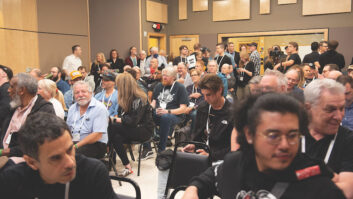
Photo: Emily Shur
Craig Schumacher describes the process of making Neko Case’s latest magnificent album as a process involving critical relationships and balance: “When she’s here, it’s all about the studio, and my dog and her dog, and feeling good, and going out to eat at the right time, and hanging out with the boys, and getting in the right headspace to come back and do vocal takes and have them feel right. We have a process that’s all about friendship and the comfort that allows her to feel confident that these basics we’re doing are good enough to push forward.”
Case doesn’t do all of her recording at engineer/producer/owner Schumacher’s Wavelab Studios in Tucson, Ariz. But The Worse Things Get, the Harder I Fight, the Harder I Fight, the More I Love You, Case’s latest collection of eloquent, varied original compositions, is the fourth album running where she’s used the studio as a home base. It’s at Wavelab that she, along with some of her favorite musicians, begins to explore musical ideas and sets about taking those ideas from brain to tape. Co-producer Schumacher and his engineer, Chris Schultz, continue to be integral to Case’s creative process, which is all about finding the right way into each song.
There are a lot of full-band tracks on this album, some with half a dozen guitar and/or synth parts added, but that’s not always Case’s desired approach. The song “On From Nowhere,” for example, shines from a more simple place, with a folky arrangement of acoustic guitar and delicate vocal arrangements. “It was originally a band song, and we had a great arrangement of it, but she was like, ‘My band doesn’t get this. It’s a feel thing and I can’t explain it,’” Schumacher recalls. So he and Schultz asked Case to play the acoustic guitar and sing the song, the way she heard it in her mind. Then, they spent some time playing with her guitar part to adjust the timing to match her vocal performance. But when Case returned to the studio, she felt the timing was too rushed in places, and she wanted guitarist Jon Rauhouse to play the guitar part. She asked Schultz and Schumacher to un-fix the timing to convey that feel to Rauhouse, rather than focus on turning her performance into the final take.
“We made a guide track out of her acoustic part, which she felt got to a place where it was ‘If I could play it how I wanted to play it, then this is how it would feel,’” Schumacher explains. “We sent that to Jon so he could practice and then come in prepared with all of that feel, the pushes and pulls that she wanted there, so they could perform it together.”
In an interview with NPR last spring, Case was still in the thick of album sessions, and she admitted that her songs were proving somewhat elusive in the studio: “I’ve never worked on a record where I couldn’t recognize the songs when I went to rehearse them,” Case said, going on to talk in detail about sounds for the song “Where Did I Leave That Fire,” an echoing, ominous-sounding song about struggling with identity and inner strength. The artist told NPR that the song made her feel like she was living in a submarine, so she asked Schultz to create an intro for the track using submarine sounds. The effect is brilliant: What sounds more strange and lonely than submarine signals?
“I just went online and found free submarine sounds, sonar sounds,” Schultz says. “I kept scrolling and trying them, and Neko would pop her head up and say, ‘Oh, I like that one!’ I probably found eight that we liked, and ended up actually using five or six. I made a loop of one and then started making loops of the others, but they were different lengths so they would start and end at different times. The fact that they’re not in time with each other makes it more fun.”
The dark, questioning mood of “Where Did I Leave That Fire” is further realized with some low, looped synth and guitar tones; processed, hissing percussion; and watery-sounding piano glisses, like rushes of bubbles; and of course Case’s gorgeous, carefully arranged vocals, which are always captured with the same model microphone.

Craig Schumacher (left) and Chris Schultz
Photo: Karen Lustig
“That’s always an Audio-Technica 4050, in omni, to an Avalon AD2022 mic pre, and this time an Alan Smart C1 compressor going in, just to tame any transients,” Schultz says. “She’s really familiar with that mic and she knows how to work it.”
“With the 4050 in omni, you’re not going to get a lot of proximity effect,” Schumacher points out. “It’s really gentle on the female voice, so the dynamic range of her voice can go from whisper-quiet to super-loud, and she knows, and we know, that the mic is always going to come through for her. It’s been her mic for the past three records.”
Schumacher estimates that, though some parts were recorded in other studios, in New York, L.A. and Oregon, about 85 percent of the lead vocals on the album were done at Wavelab. Conversely, the album’s mixing engineer, Tucker Martine, says a similar percentage of the harmonies and backing vocals were done in his studio, Flora (florarecording.com), along with additional guitar parts, percussion and other elements.
“We ended up doing more than had been planned,” Martine says. “The first chunk of time when Neko was here had originally been scheduled as mix time, but when she got here, the record was still in a somewhat amorphous state. We rifled through things, and spent time discovering what parts were essential and what she wanted to be redone. It was, ‘open up the hood’ and take stock of the anatomy of the whole thing. I think that often, the way Neko works is to have a starting point, then jump in. The puzzle definitely revealed itself as we went along; we didn’t always know what the next piece would be.”
At Wavelab, Schumacher and Schultz had recorded numerous parts to their MCI JH16 24-track machine, and others into Pro Tools. Schultz transferred everything to Pro Tools files before sending the tracks to Martine.
One song that incorporates elements and ideas put forth in both Wavelab and Flora is the first single, “Man,” a big, full rock ‘n’ roll track that makes a strong statement about gender roles and delivers a powerful impact musically.
“That’s one of the songs that, when I first got the batch of materials, was making me scratch my head,” Martine recalls. “It was skeletal and it wasn’t quite making sense yet. It was hard to wrap our heads around it until we added several more electric guitars. Neko played some and Steve Turner from Mudhoney, and Matt Ward [of She & Him] played on that, too.”
Drums had already been laid down in Wavelab, with Kurt Dahle of New Pornographers playing the studio’s Ludwig kit; Schumacher says he switched out the kick for a larger 26-inch drum at Dahle’s request. But Martine says the bigger guitar sounds were making the drums “smaller and smaller. I wasn’t able to get them to have so much impact in their organic acoustic state.” So, he and Case embellished with a prominent tambourine part and some drum samples.
“I reinforced the drums with samples just on this one song, because it seemed that for it to work, it really needed to be hitting hard,” Martine explains. “I have a library of drums that I’ve amassed over the years, some of which I played myself. This was right after I got the Drumagog plug-in, and I used that as well. I also ran the snare samples through some distortion with the Thermionic Culture Vulture.”
The distorted samples create a hissy, arresting sound. “I wasn’t sure I wanted to go that direction, but I heard Neko from the back of the room say, ‘Yeah, that sounds awesome!’” Martine says.

Tucker Martine mixing in Flora, where he also worked on harmonies, backing vocals and a few overdubs.
Photo: Justin Quigley
The time Martine had blocked out for Case’s mix quickly evaporated, so when he needed to move onto a different project for a while, Case returned to Wavelab.
“At that point, Neko had a scratch vocal on ‘Man’ that was recorded to an SM58. She texted me from Tucson saying, ‘I’m trying to re-do the vocals on “Man” with the 4050, but it’s not as cool. Can we use some of the old vocals from the SM58 along with some new vocals that were done with the 4050?’ I told her, ‘Yeah, we’ll make it work,’ because I got the impression that they were struggling to duplicate something about the vibe of the old vocals.”
The tracks then came back Martine to be mixed. “But then I had to try to figure out which of the vocal recordings were done with the 4050—and then I went down the rabbit hole of trying to match the 58 vocals to that the best I could. I ran the SM58 vocals through two Pultecs—to one I added some 10k, and the other I added some 16 for some top end and then for some air. Then both of those went through a [Empirical Labs] Distressor.”
Martine says he sent all the album tracks through an SSL G Series compressor and a Retro 2A3 EQ: “That Pultec-style EQ adds a little bit of air,” he says. “Also, all the electric guitars usually went through the [Manley] Massive Passive for a little bit of 3k, which I think the Massive Passive does really well.
“Also I had this setup going where my console has eight stereo bus return faders, and on each one, I patched in a different compressor or effect so, at any moment, I could say, ‘I wonder what these drums would sound like if they’re hitting the Chandler TG1? Or the Neve 33609? Or if I send the snare to the spring reverb?’ Any one of those things could be done at the press of a button without having to patch a bunch of stuff in.”
“I’ve always loved Neko’s records and been fascinated by how unique they are andwondered how they came together,” Martine says. “Something about them sounds really natural and organic, and then something has this other dimension to it. So, anytime she might make a request that I’m not sure can be done, my answer was always, ‘Yeah, let’s find a way.’ I love those challenges anyway because that’s when I really start learning things. I like getting out of my comfort zone if I have faith that at the end of the day we’re going to wind up somewhere we want to be.”







